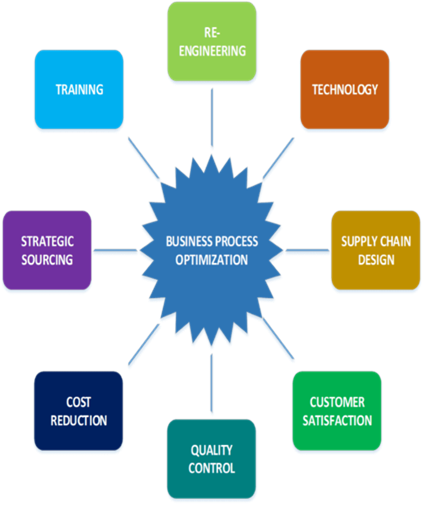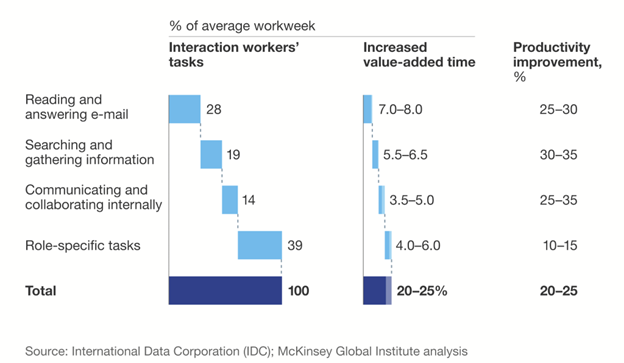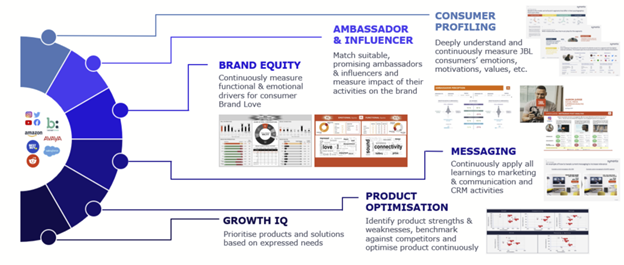Is your business struggling to achieve optimal efficiency and you are unsure how to handle a business process optimisation?
You are not alone. In our digital, fast-paced era, remaining competitive and delivering high-level results is a constant challenge for every company. Inefficient processes jeopardize growth and productivity, lead to subpar products and/or services and finally to unhappy clients.
The solution is streamlining your business processes. Untapped potential can be revealed by refining and fine-tuning your workflows, resulting in enhanced productivity, shrunk costs and delighted customers.
Keep reading to find out key strategies, best practices and top technologies that will support you in driving the desired success. Let’s dive in and get ready to empower your organization to thrive in today’s dynamic business environment.
What Is Business Process Optimisation?
In simple words, business process optimisation (also known as BPO) is a method of fine-tuning internal and external workflows to achieve the maximum performance possible. Or harmonizing all parts within an organization to function in a frictionless, productive manner.
It’s more than just a concept; it’s a transformative power that can unleash the real potential of a business.
The most common business process optimisation examples are:
- Eliminating bottlenecks and redundancies
- Improving communication
- Streamlining operations and reducing inefficiencies
- Reducing waste
Why Is Business Process Optimisation Important?
Having optimised processes is paramount for any business. Just imagine a fine-tuned engine that runs smoothly, frictionless and without wasting energy. It’s the equivalent of optimised processes for a business. They have the power to propel the company towards its purposes with enhanced agility and speed.
Process optimisation for businesses has significant benefits:
- Increased productivity
- Minimised costs
- Improved customer satisfaction
- Augmented profits
- Ability to quickly adapt to change
- Get an edge over the competition
- Reduced redundancy and waste
Simply put it’s the secret weapon that ensures your company functions always at its best.
When looking to optimise your business processes, first you have to know and understand them.

Source: CatalystConnection
Overview of Your Business’s Current Processes
To have a clear understanding of your business’s existing workflows and processes you have to follow these steps:
Identify main workflows and processes:
- Create a comprehensive overview of all the processes that are in use in your organization.
- Identify the key players involved (departments and individuals).
- Discover the critical path – the core processes that sustain your business expansion.
Analyze inefficiencies and bottlenecks:
- Spot the places where the processes get inefficient, where they get stuck or slow down.
- Identify what causes the bottlenecks.
- Evaluate the impact of these bottlenecks on productivity and overall customer satisfaction.
Gather data and put in place metrics for evaluation:
- Leverage data to uncover valuable insights related to your business’s processes. Use a text analysis tool like Symanto to obtain actionable advice and business-critical metrics to improve your business’s performance. Access more than 2000 online data sources (social media, company databases, search data, click stream data, ESG databases, etc.) and make use of machine learning and generative AI to find out ways of improving your business.
- Track the current performance of your processes. Monitor error rates, cycle time, throughput, etc.
- Get feedback from your employees and execute a holistic evaluation.
This overview sets the foundation for successful optimisation. It is vital to identify correctly the areas that need improvement and help you make data-based and informed decisions.
Business Process Optimisation Principles
Several fundamental principles guide your way toward high efficiency and real success. To unlock the full potential of your company, it’s compulsory to take into consideration the following principles:
Simplify and streamline
- Identify and eliminate redundant steps and/or processes.
- Consider Lean principles to minimise waste and optimise workflows.
- Concentrate on value creation and prioritise activities that contribute directly to it.
Integrate technology and automation where possible
- For time-consuming and repetitive tasks look for automation solutions.
- Integrate technology to improve speed, accuracy and productivity.
- Pick tech tools that integrate and align with your business-specific needs.
Free up your employees’ time and energy by automating recurring tasks. According to a study by McKinsey Global Institute workers spend just 39% of the average workweek on role-specific tasks. The rest of the time is split between searching and gathering information, communicating and collaborating with colleagues, and reading and responding to emails.

Research and implement any tools and technologies that can help increase the amount of time your employees spend getting on with the tasks they’re hired to do.
Email automation is one such example. Create templates for your employees to send out when an event is triggered. For example, you can create a series of email templates to help onboard new clients.
As for searching and gathering information, the Symanto Insights Platform has been designed to optimise the time spent gathering data to help with research for product development and marketing and business strategy. Symanto automatically processes qualitative data online into valuable insights, a process that would take weeks to conduct manually.
Implement cross-functional communication and collaboration
- Encourage collaboration among teams and departments.
- Implement clear communication and information exchange venues.
- Align cross-functional teams with common goals.
Consider agile methodologies and continuous improvement
- Promote adaptability to be able to respond fast to business-changing circumstances.
- Make business process optimisation an iterative approach to be able to stay ahead of the curve.
- Create a Kaizen mindset – a continuous improvement culture.
The above-mentioned principles are the essence of optimisation – a blend of collaboration, efficiency and adaptability. And they act in synergy to build the future success of your optimisation endeavours.
Remember your business’s journey towards optimal efficiency is not a sprint, it’s a marathon.
Business Process Optimisation Steps
Once you have a clear picture of the current situation of your business processes and have put in place an appropriate strategy, the mechanism of process optimisation will include five phases:
- Identify the business processes that need optimisation. Prioritize them and consider the final goals to be reached. Choose the right performance indicators to measure the success of the optimisation efforts.
- Reengineer, rethink and spot the improvements that are necessary. Collaborate with your team members and see how you can make processes more efficient.
- Analyze the newly designed business processes and verify again if they are capable of reaching the established goals. Are there any redundant operations, dead times, wasted resources or time?
- Implement the change and include automation where the process allows it and delivers better results. Better automated systems have the potential to execute parts of the business process in a faster and error-free way.
- Monitor the output and implement a continuous improvement culture. Overview and tweak the business processes until the goals are reached and after that in a perpetual manner to gain an edge over the competition.
Business Process Optimisation Best Practices
Multi-objective business process optimisation requires the consideration of a set of best practices. Most prominent are:
Mapp and audit the business processes
- Execute a comprehensive process audit to have a clear image of the current situation.
- Draw process maps to be able to visualize the flow of tasks and department interactions.
- Spot the gaps, bottlenecks and inefficiencies that affect the current flow of operations.
Set clear goals
- Define specific, realistic, and clear optimisation goals for each business process.
- Establish key performance indicators to measure progress and success.
- Ensure that the set goals seamlessly align with the company’s available resources and capabilities.
Involve stakeholders and employees
- Empower your team and involve it in the optimisation operations.
- Promote an accountability and ownership culture among employees.
- Look for a holistic approach, and ask for input from all relevant stakeholders.
Your employees are a vital asset when it comes to determining how to streamline your internal systems and operations. They live your business day-to-day. Workflow problems and lack of efficiency in your organization are their daily frustration.
Coordinate with your human resources department to encourage your employees to give honest feedback in a way that they feel comfortable and safe. This is much more easily achieved if you’ve already invested in creating an empathetic, non-hierarchical and collaborative company culture.
The Symanto Insights Platform has the ability to scan all of your reviews to discover recurring topics. Use this information to learn where frustrations lie and work to improve them. This will not only help with Business Process Optimisation, but it will also improve employee satisfaction, and consequently the overall efficiency.
Align business strategy and optimisation processes
- Link each newly optimized process with the current overall business strategy.
- Give priority to core objectives and optimize first the processes that have a greater impact on key goals.
- Let room for future changes, and design agile processes to be able to adapt fast if needed.
Technologies and Tools to Optimise Business Processes
In our digital environment, technologies and tools have the power to make or break your business. They are your weapons to reach new levels of productivity and efficiency.
Here are some types of tools your business may need:
Process automation software
- Automate repetitive activities with the help of an automation software solution.
- Design custom workflows that align seamlessly with your optimized processes.
- Accelerate task completion, minimize manual human errors and get better results.
Enterprise resource planning systems – ERP
- ERP solutions centralize data under the same dashboard and facilitate integrated management.
- Streamline resource allocation for superior results and waste reduction.
- Provide access in real-time to data and insights related to operations and overall business processes.
Business intelligence and data analytics tools
- Get reliable data-driven insights via data analytics and data analysis tools to improve your business’s process performance.
- Make decisions based on real data.
- Spot patterns and trends to uncover hidden opportunities for improvement.
Customer relations management systems – CRM
- Improve customer relationships and customer experience with a CRM, and carefully manage customer feedback and interactions.
- Centralize client data for a comprehensive overview of your target audience.
- Personalize experience and aim for exceptional customer support to drive engagement.
Support your team to work smarter not harder via a cohesive ecosystem of integrated management tools.
When choosing the tech to work with pay attention that the real magic lies in merging the right advanced tool with the existing human expertise.
Main Challenges Encountered in Business Process Optimisation
The ever-evolving business environment inevitably spreads a large variety of hurdles in a company’s evolution.
Most common challenges that appear during business optimisation efforts are:
Resistance to change and change management
Sometimes part of the team members will resist the change requirements that will be implemented. Consequently, it’s important to inform all stakeholders in advance and clearly communicate the benefits of optimisation. Also, involving key team members and gaining support from leaders to drive enthusiasm for the optimisation is highly desirable.
To prevent resistance to change is recommended to create a company culture that supports continuous learning and improvement and perceives the change as a growth opportunity.
Finding the right balance between flexible and standard
Evaluate the business processes to identify where standardization is an absolute must and where flexibility is needed for quick adaptation. And personalize optimisation to match each process.
Risk management
Before proceeding to the process optimisation conduct a risk assessment to spot potential problems and challenges during the process. Put in place strategies to minimise the risks of potential disruptions and contingency plans for unforeseen situations.
The business process optimisation journey is a transformative endeavour that implies finding the correct balance between innovation, processes, and the team involved.
Measuring the Success and Evaluating the Optimisation Process
The success of the business optimisation process depends on the results it delivers. As such, they need to be evaluated.
First, you need to decide on the KPIs relevant to the process improvement, that align with the optimisation goals and offer a coherent benchmarking basis.
Constantly monitor progress, adjust and adapt strategies as needed to ensure they are on the right path to reach the established optimisation goals. Adopt a continuous improvement approach to fine-tune the optimisation efforts.
Celebrate success and share it with the team, recognise and appreciate the hard work of employees involved in the optimisation process. Encourage feedback from all levels and gain insights for further improvements and development.
Real-Life Case Studies and Business Process Optimisation Examples
Here are some concrete examples of BPO, what were the problems, what were the solutions implemented and what results were obtained:
Service Provider Company X: Using automation to improve customer service
Problem: Company X had difficulties managing an increasing volume of customer inquiries. This resulted in delayed response and a growing number of unhappy clients.
Solution: Implementation of a new CRM system powered by high-level automation capabilities. The system automated a number of repetitive tasks related to ticket handling and response management. For example, automated responses were set for specific queries such as password reset, AI chatbots took charge of a part of service-related questions, and tickets were routed automatically based on the case category.
Results: Response time shrunk by 39% and customer satisfaction score increased by 26.5%
Conglomerate Company Y: Implementing new ERP solution to streamline efficiency and save costs
Problem: Company Y, an organization with multiple business lines encountered difficulties with resource allocation and experienced inefficient management costs.
Solution: Implementation of a new ERP system that integrated better with their business goals and operations and helped them centralize data in a more meaningful manner and improve operations across business lines.
Results: The new ERP provided real-time insights, allowing the identification of significant cost-saving opportunities and resource allocation enhancements. A new strategic resource planning generated an 11% reduction in costs and a 23% increase in operation efficiency.
Consumer electronics seller Company W – A more complex approach looking to develop a full potential program centred around customer centricity that boosted the topline and streamlined the company’s operations.
Problem: Company W had gone through a series of two consecutive large mergers. Even if the brands were successful from a commercial point of view, they identified an important value creation potential in becoming more consumer-centric.
Solution: Symanto conducted a full commercial potential assessment followed by a series of customer-centric transformations in multiple functions: e.g. Customer care, MarCom, Product Development, D2C, Store Operations
Put in place a new KPI system to drive alignment across functions.
Analyzed a very diverse and large set of data including internal data: e.g. CX transcripts, CRM and external data including reviews, forums, social media, influencer and clickstream data.
Results: Repositioned the brand. Guided the product teams to make the right decisions on product feature enhancements. Identified marketing activities and ambassadors to increase brand love. Reduced inbound volume of customer care by 20% in total by pre-emptive eMails on pain points.

Get in touch with Symanto to obtain powerful insights that have the power to enhance your company’s future growth via business process optimisation. And see what remarkable impact may be generated from analysing all your data.

